Celery for an infant: how to properly introduce it into complementary foods
Celery is a unique crop that has virtually no contraindications for use. The roots, stems and green leaves are used for food. The product has a rich vitamin and mineral composition, pleasant taste and aroma.
From the article you will learn whether it is possible to give celery to an infant, where to start introducing complementary foods, how to prepare the product and in what case it should be abandoned.
Chemical composition and nutritional value
Celery has a balanced chemical composition, containing almost everything known vitamins and minerals.

| Name | Content | Norm |
| Vitamin A | 3 mcg | 900 mcg |
| Beta carotene | 0.01 mg | 5 mg |
| Vitamin B1 | 0.03 mg | 1.5 mg |
| Vitamin B2 | 0.06 mg | 1.8 mg |
| Vitamin B4 | 9 mg | 500 mg |
| Vitamin B5 | 0.4 mg | 5 mg |
| Vitamin B6 | 0.15 mg | 2 mg |
| Vitamin B9 | 7 mcg | 400 mcg |
| Vitamin C | 8 mg | 90 mg |
| Vitamin E | 0.5 mg | 15 mg |
| Vitamin H | 0.1 mcg | 50 mcg |
| Vitamin K | 41 mcg | 120 mcg |
| Vitamin PP | 1.2 mg | 20 mg |
| Potassium | 393 mg | 2500 mg |
| Calcium | 63 mg | 1000 mg |
| Silicon | 29 mg | 30 mg |
| Magnesium | 33 mg | 400 mg |
| Sodium | 77 mg | 1300 mg |
| Sulfur | 15 mg | 1000 mg |
| Phosphorus | 27 mg | 800 mg |
| Chlorine | 13 mg | 2300 mg |
| Iron | 0.5 mg | 18 mg |
| Iodine | 0.4 mcg | 150 mcg |
| Cobalt | 1.8 mcg | 10 mcg |
| Manganese | 0.158 mg | 2 mg |
| Copper | 70 mcg | 1000 mcg |
| Molybdenum | 4 mcg | 70 mcg |
| Selenium | 0.7 mcg | 55 mcg |
| Fluorine | 4 mcg | 4000 mcg |
| Chromium | 2.4 mcg | 50 mcg |
| Zinc | 0.33 mg | 12 mg |

Nutritional value of petiole celery (per 100 g):
- calorie content - 13 kcal;
- proteins - 0.9 g;
- fats - 0.1 g;
- carbohydrates - 2.1 g;
- fiber - 1.8 g;
- water - 94 g.
Nutritional value of root vegetables (per 100 g):
- calorie content - 34 kcal;
- proteins - 1.3 g;
- fats - 0.3 g;
- carbohydrates - 6.5 g;
- fiber - 3.1 g;
- water - 88 g.
Interesting things on the site:
Beneficial features
Celery has beneficial properties for children's bodies:
 eliminates inflammatory processes;
eliminates inflammatory processes;- accelerates the healing of wounds and burns;
- prevents the development of cancer cells;
- removes toxins and radionuclides;
- increases the body's defenses;
- improves digestion;
- increases hemoglobin;
- has antiallergic, antiseptic effect;
- has a mild laxative effect;
- reduces swelling;
- regulates metabolism;
- relieves pain;
- removes uric acid salts;
- awakens appetite;
- helps cure nephritis;
- calms the nervous system and has a hypnotic effect.
When to introduce celery into your child's diet?
At what age can children be given celery? Root vegetables, petioles and greens do not provoke allergies and even help cope with them. Pediatricians recommend starting to introduce your baby to the product after 7 months, when zucchini, cauliflower, broccoli and potatoes already appear in the diet. Previously, it was not recommended to introduce the product into the infant menu due to the risk of disruption of digestive function and lack of enzymes to break down coarse fiber.

For the first time, just cut off a small piece of the root and add it to the vegetable broth.. Celery has a pronounced taste and aroma and may not appeal to little picky eaters.
Advice. Start introducing a new product with 50 g. Observe the child’s reaction for 2 days.If there is no reaction, gradually increase the portion to 100 g. Some children refuse food with a new, unfamiliar taste. Don't despair - offer to try the same dish in a week.
Roots, greens and celery stalks are used as complementary foods.. The product must undergo heat treatment, since the digestive system of an infant is not able to cope with coarse dietary fiber.
It is better to add greens at the end of cooking - this way it will undergo minimal heat treatment and retain useful substances.
The petioles and root are placed in vegetable and meat soups, then beat with an immersion blender until pureed. Children after one year old should not grind food. By this time they are able to chew small pieces of food.
It can be useful:
How to properly introduce complementary foods
Vegetables with a neutral taste, white or green, are suitable for the first feeding of a baby. - cauliflower, broccoli, zucchini, potatoes. From about 7 months, nutritionists recommend introducing your baby to new tastes.
The opinions of pediatricians in different countries regarding the introduction of celery into the diet differ slightly. In France, celery is introduced at the same time as broccoli, since the product does not cause an allergic reaction. In Russia, experts advise holding off on introducing celery and starting adding it to dishes after becoming familiar with poultry meat. All dishes must be pureed until smooth.

Up to 1-1.5 years, the root, petioles and greens must undergo heat treatment. If the child appreciates the taste and aroma of the product, you can gradually switch to eating it raw.Freshly squeezed juice is mixed with carrot or apple juice. The drink stimulates digestive function, normalizes appetite, and replenishes vitamins.
When the child learns to chew solid food thoroughly, raw celery root and stalks are added to vegetable and fruit salads. As a rule, this occurs no earlier than 2 years. The product is combined with apples, dried apricots, prunes, raisins and nuts. To dress salads, use low-fat natural yogurt without sugar or vegetable oil.
Finely chopped leaves are added to broths, soups and salads.
Celery root is boiled in steam or water, combined with other vegetables and meat.
Celery dishes for young children
The menu for babies is not very diverse. At this age, it is important to properly begin to introduce the fragile digestive system to new foods. Cream soups, purees, and casseroles are prepared from celery.
To prepare the soup you will need the following ingredients::
- potatoes - 1 pc.;
- celery root - 200 g;
- carrots - 100 g;
- cauliflower - 200 g.
Wash the products thoroughly and place in boiling water. Add a little salt to the broth and cook the vegetables until fully cooked. Use a slotted spoon to transfer the ingredients into a separate container and blend into a puree. Pour in 1-2 ladles of vegetable broth to the desired consistency.

To prepare celery root puree, take:
- white loaf pulp - 10 g;
- celery root - 50 g;
- milk - 1 tbsp. l.;
- butter 82.5% - ½ tsp;
- salt - to taste.
Wash the root, remove the skin, cut into cubes and boil in salted water. Soak the loaf in milk. Mix celery with bread crumb, add butter and puree.
Celery casserole is suitable for children over 1 year old. Prepare the following products:
- cottage cheese 5% - 100 g;
- petiole celery - 100 g;
- egg - 1 pc.;
- flour - 1 tbsp. l.;
- hard cheese - 25 g.
Grate the cheese, mix with cottage cheese, add egg and flour, beat with a blender into a homogeneous mass. Finely chop the petioles, put them in the dough and place them in a silicone mold. Bake for 40-45 minutes in an oven preheated to 180°C.

Potatoes stewed with celery are very filling and appealing to small children.. The dish is adapted for children 1.5 years old.
Ingredients:
- potatoes - 1 pc.;
- celery root - 100 g;
- ½ onion;
- carrots - 1 pc.
Peel the vegetables, cut into cubes, place in a saucepan, add finely chopped onion. Pour boiled water so that it covers the vegetables, add salt, pour in 1 tbsp. l. oil or 1 tsp. butter. Simmer covered over low heat until done. If desired, the stew can be pureed.
Fresh and crispy celery salad with apple served to children after two years:
- Peel the apple, grate it, sprinkle with lemon juice to prevent it from darkening.
- Finely chop one stalk and add to the apple.
- Season with 1 tbsp. l. natural yogurt.
Harm and contraindications of celery for young children
Besides the obvious benefits, celery can harm a fragile child's body for diseases of the digestive system (ulcers and erosions of the stomach, disturbances in the breakdown of food). The product is contraindicated in case of exacerbation of nephritis and pyelonephritis, diseases of the genitourinary system.
It is better to avoid introducing celery into your baby’s diet if hemorrhagic vasculitis (increased permeability of blood vessels), epilepsy (the product provokes seizures), high blood pressure, individual intolerance.
Conclusion
At what age can you give celery to infants? This issue is discussed at a face-to-face appointment with a pediatrician. Most experts recommend introducing root and petiole celery into the diet of children starting at 7-8 months, and green leaves after a year. The product does not cause allergies, helps improve digestion, strengthen the immune system and calm the baby’s nervous system.
Complementary foods should consist of heat-treated and pureed foods. Celery is contraindicated for infants in its raw form due to the large amount of fiber, which is difficult to digest.